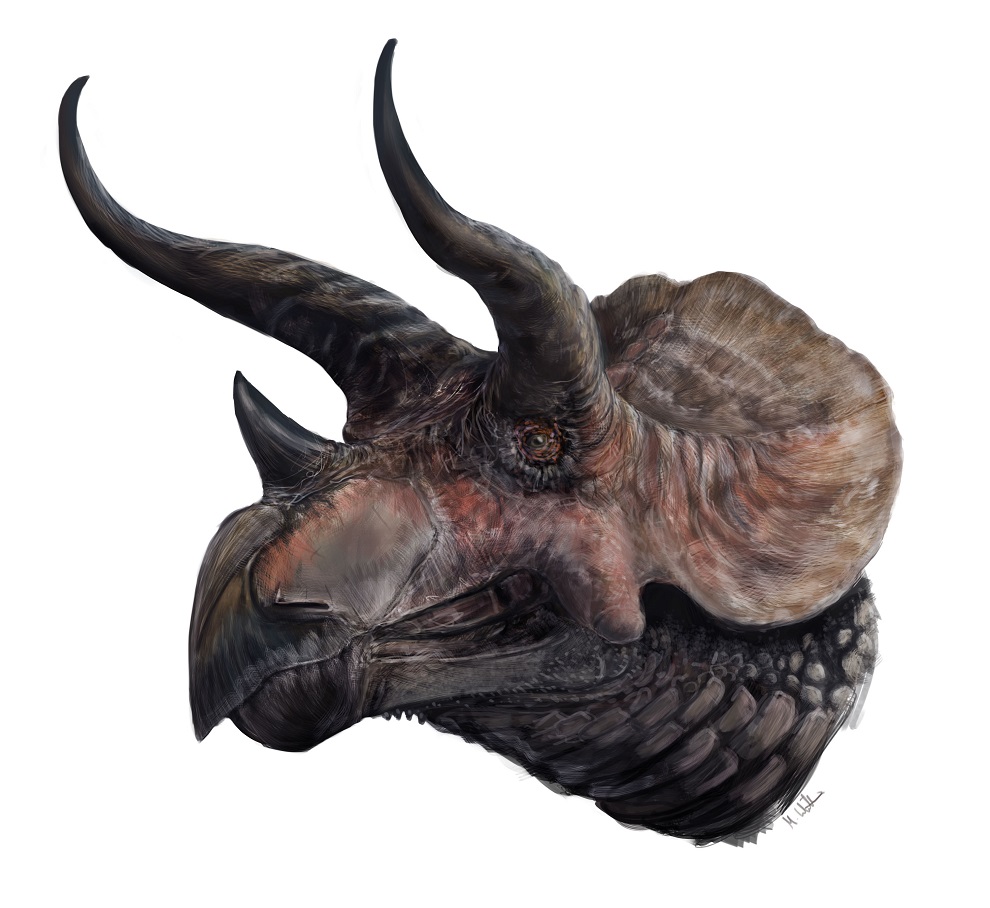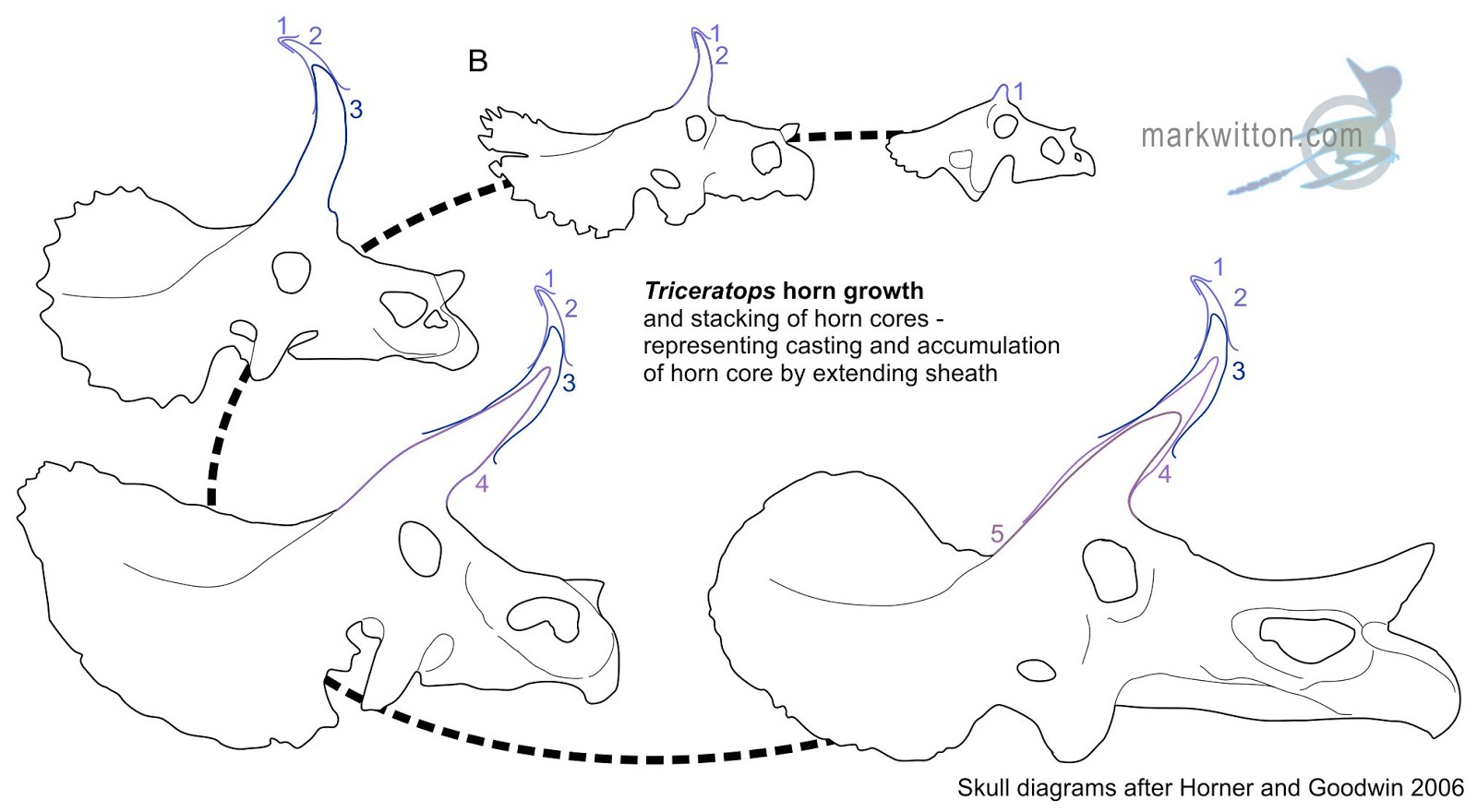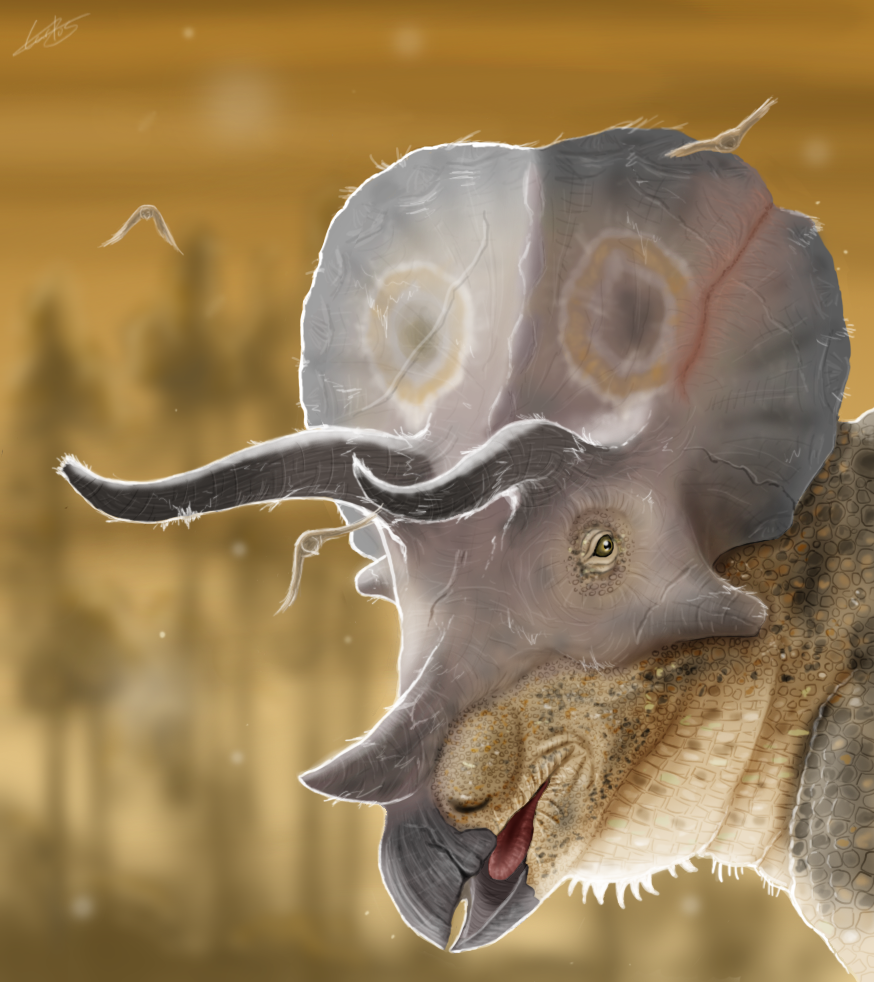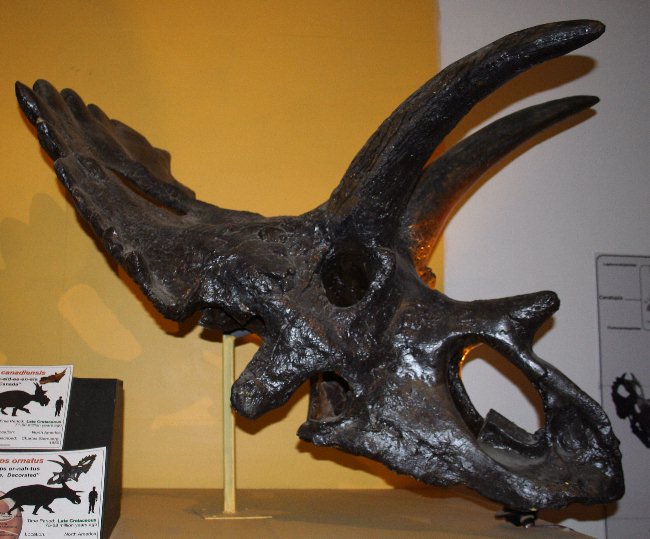|
|
Post by dinosauria101 on Oct 18, 2019 15:30:57 GMT 5
So, what's your outlook on ceratopsians in comparison with other horned animals (antelope, bison, Cape buffalo, rhino, etc)?
I think they're more formidable at parity for several reasons:
-More robust
-Better placed horn/horns which they can simply gore with as opposed to swinging their heads significantly to do so
-Ball and socket joint which allows them to rotate their heads and turn their horns as needed
-A solid bony frill to protect their neck
-A sharp beak which can be used as a weapon as well
|
|
|
|
Post by Verdugo on Oct 18, 2019 21:08:33 GMT 5
There is a post by Mark Witton suggesting that the horns of Triceratops are probably not even straight, you might want to give it a read.  Witton pointed out that given the current evidence we have, this is the most probable case and this is how most modern animals actually grow their horns. To suggest that Triceratops is somehow against the norm (aka 'straight horn model') will require more evidences. |
|
|
|
Post by dinosauria101 on Oct 18, 2019 21:17:31 GMT 5
VerdugoInteresting! I did not know that was a possibility. One thing that seems a bit off though, is that all the analogies are mammals, whilst Triceratops was a reptile (not discounting it being valid, just wanted to point that out). Even still though, those horns are not useless. And even with all the above in mind, the other factors as well as the other ceratopsian species, as well as the fact they don't need to pivot their heads to any large degree, probably maintain my POV
|
|
|
|
Post by Verdugo on Oct 18, 2019 21:34:21 GMT 5
One thing that seems a bit off though, is that all the analogies are mammals, whilst Triceratops was a reptile (not discounting it being valid, just wanted to point that out). Even still though, those horns are not useless. Witton has addressed that in his post: Also, please note that the model by Witton is a conservative model, assuming minimal keratin growth (it's a good thing in paleontology to be rather conservative). If the animal grows more keratin than this then you could expect the shape and curvature of its horns to be even more striking. |
|
|
|
Post by Infinity Blade on Oct 18, 2019 21:54:08 GMT 5
I’ll respond to this topic more once I’m done my final class for the day.
|
|
|
|
Post by dinosauria101 on Oct 18, 2019 22:01:39 GMT 5
Witton has addressed that in his post: Also, please note that the model by Witton is a conservative model, assuming minimal keratin growth (it's a good thing in paleontology to be rather conservative). If the animal grows more keratin than this then you could expect the shape and curvature of its horns to be even more striking. Yes, true. Thanks for pointing that out. If the keratin is very long, I think there might be some 'dinosaurian gemsboks' among ceratopsians. |
|
|
|
Post by Infinity Blade on Oct 19, 2019 4:35:20 GMT 5
On keratin sheath reconstruction: yeah, I guess it's possible. In a way I could actually see that being somewhat helpful to a Triceratops. If the tips point rather upwards, that's perfect if a Triceratops gores by lifting its head up. I'm not entirely sure if they would curve quite to the extend Mark Witton has drawn them, though. Even looking at his tracing of a Triceratops skull with hypothetical horn sheathes over the horn core, the horn core itself isn't particularly indicative of a curve upwards. The illustration of a bovid horn he modified from Goss (2012) has a horn core with a shape that does seem like it would bear a very curved horn sheath in life. Now granted, I'm talking about illustrations here, not actual specimens. Looking at images online, I do think at least some Triceratops specimens have horn cores with subtle upwards curves, so I think their horn sheathes might have been somewhat more upwards curving in life. But again, not sure if it's necessarily to the extent Witton imagined it for the reason I gave above. And some Triceratops, like the top specimen in this-> photo could, if anything, use a bit more upwards curvature IMHO if they want to effectively stab upwards against a marauding tyrannosaur. On frills: not all ceratopsids would have had thick solid bone frills to protect their napes. In fact, it may be that most wouldn't. If I remember correctly many ceratopsids had thin frills with massive fenestrae between them. I'd appreciate if someone could confirm or refute my claim here, but I think it's really just Triceratops and the likes (so maybe Eotriceratops too?) that had the thick solid bone frills. That said, some ceratopsids also have large horns on their frills that could be used for defensive purposes as well ( Styracosaurus' frill horns come to mind).
|
|
|
|
Post by dinosauria101 on Oct 19, 2019 4:39:30 GMT 5
On frills: not all ceratopsids would have had thick solid bone frills to protect their napes. In fact, it may be that most wouldn't. If I remember correctly many ceratopsids had thin frills with massive fenestrae between them. I'd appreciate if someone could confirm or refute my claim here, but I think it's really just Triceratops and the likes (so maybe Eotriceratops too?) that had the thick solid bone frills. That said, some ceratopsids also have large horns on their frills that could be used for defensive purposes as well ( Styracosaurus' frill horns come to mind). Oh, yes, that is true. Styracosaurus would probably have had some defensive use for the frill horns. As for the first part, even a fenestrated frill is better than nothing, and no herbivore today has any frill. So I think my point still stands |
|
|
|
Post by Infinity Blade on Oct 19, 2019 4:42:39 GMT 5
It's not just having fenestrae, it's being a very thin structure altogether.
|
|
|
|
Post by dinosauria101 on Oct 19, 2019 4:46:17 GMT 5
It's not just having fenestrae, it's being a very thin structure altogether. Still superior to NOTHING. And surely the bone wouldn't have been paper-weak, would it have? Anyhow, after looking up some various ceratopsian skulls, it seems paper thin with large holes is not the norm; most seem to have a reasonably robust/solid frill with small to medium holes. |
|
|
|
Post by Infinity Blade on Oct 19, 2019 5:31:03 GMT 5
Okay, let me make my point clear: it's pretty much nothing. The actual bony frill itself (any horns, hornlets, or other hard structures aside) will provide slight protection at best, especially if we're talking about a similarly colossal animal.
Yeah, it varies with taxa. Still, it would be nice to know how thick some of those frills were.
|
|
|
|
Post by Verdugo on Oct 19, 2019 11:06:54 GMT 5
On keratin sheath reconstruction: yeah, I guess it's possible. In a way I could actually see that being somewhat helpful to a Triceratops. If the tips point rather upwards, that's perfect if a Triceratops gores by lifting its head up. I'm not entirely sure if they would curve quite to the extend Mark Witton has drawn them, though. Even looking at his tracing of a Triceratops skull with hypothetical horn sheathes over the horn core, the horn core itself isn't particularly indicative of a curve upwards. The illustration of a bovid horn he modified from Goss (2012) has a horn core with a shape that does seem like it would bear a very curved horn sheath in life. Now granted, I'm talking about illustrations here, not actual specimens. Looking at images online, I do think at least some Triceratops specimens have horn cores with subtle upwards curves, so I think their horn sheathes might have been somewhat more upwards curving in life. But again, not sure if it's necessarily to the extent Witton imagined it for the reason I gave above. And some Triceratops, like the top specimen in this-> photo could, if anything, use a bit more upwards curvature IMHO if they want to effectively stab upwards against a marauding tyrannosaur. It's not exactly the shape of the adults bone cores that determine the shape of the keratin sheath, it's actually the shape of the younger juvenile's bone cores according to Witton. You can see his illustration:  Keratin does not grow from the outside in, it grows from inside out. New keratin sheaths/layers grow from the bone core and push the old sheaths out. As you can see in Trike's ontogeny, it has upward curved bone cores in its juvenile state, this cause the the keratin sheaths to be shaped like that (keratin sheath 1, 2, and 3 in Witton illustration). In its adult state, these earlier keratin sheaths (1, 2, 3) still retain and and thus it creates an upward curved tip like that. Now there two possible fallacies with Witton's model: 1. Our understanding of Trike's ontogeny is wrong and Trike's juvenile are not actual Trike's juvenile after all (juvenile of another species for example). Though i think this is unlikely to be the case but who knows, maybe new discoveries will change that idk. 2. Trike can shed its entire keratin sheath and grow a new (straight) one in its adult stage. But as Witton has pointed out in his post, Trike's morphology does not indicate such thing and shedding the entire keratin sheath is a rare instance in animal kingdom aka not the norm. Witton also pointed out it's possible for the tip to break of due to external factors (abrasions) and thus the horns will become slightly straighter. However, in that case, the horns will have blunt and worn tips instead of the finely-sharpened 'swords' that are usually portrayed. Something like this Or this This makes Trike more in line with what we see in modern horned animals like Bovids, who usually have curved horns for display purpose and for ritualised intraspecific horn-locking combats (we do have evidence of that behaviour in Trike btw). |
|
|
|
Post by dinosauria101 on Oct 19, 2019 20:06:15 GMT 5
1: Okay, let me make my point clear: it's pretty much nothing. The actual bony frill itself (any horns, hornlets, or other hard structures aside) will provide slight protection at best, especially if we're talking about a similarly colossal animal. Yeah, it varies with taxa. Still, it would be nice to know how thick some of those frills were. Looks like I forgot to reply to this 1: Well, sure. I guess the frill thing doesn't apply to a few ceratopsians after all. 2: Here are some examples:      All are moderately robust with small to medium holes |
|
|
|
Post by Infinity Blade on Oct 19, 2019 20:21:40 GMT 5
My only question to this would be, couldn’t a Triceratops just hone the tips of its horns on say, wood, to make them sharp again? Bighorn sheep may have frayed, blunted horn tips after they receive a lot of wear and damage to them, but I can imagine with their horn shape it might be difficult for them to sharpen their horns. Less so with Triceratops.
Then again, maybe this shape will eventually revert back to its curved tip, if I understand the inside-out growth pattern correctly.
|
|
|
|
Post by Verdugo on Oct 19, 2019 23:20:40 GMT 5
My only question to this would be, couldn’t a Triceratops just hone the tips of its horns on say, wood, to make them sharp again? Bighorn sheep may have frayed, blunted horn tips after they receive a lot of wear and damage to them, but I can imagine with their horn shape it might be difficult for them to sharpen their horns. Less so with Triceratops. I personally did not know about the horn 'sharpening' behaviour that you said here before reading your post. I did some preliminary research on that and i found this video: www.youtube.com/watch?v=QdjTvNOYf1oIt does indeed look like the Rhino is trying to sharpen its horn. However, i'm not sure if the Rhino here actually intended to 'sharpen' its horn to make it more effective as a weapon like the way we sharpen ours or it was just simply rubbing its horn against the pole for whatever reasons (cleaning? practising combat? maybe even pleasure?) and we just anthropomorphise and interpret its behaviour as such. For whatever reasons, it's clear that these 'animals' do not have the finesse to sharpen their horns to a fine point like human do. Such behaviour repeated over some periods probably could help making a broken horn more tip-like (a blunted tip) but something like a finely sharpened point (like what Trike's horns are usually portrayed) for me is unlikely. Regarding the possibility of such behaviour in Trike? Yeah i don't see why not. I mean do we have any hard evidences for such? No, AFAIK. But it's not unreasonable to assume that they might do something like that. I have seen some videos of modern horned animals rubbing their horns against trees for whatever reasons so it's not unreasonable to think Trike might do that regardless of whether they actually intended to sharpen their horns. It depends on the stage of ontogeny when the animal broke its horn. If the animal broke its horn in an earlier stage of ontogeny when the bone core still curved upward, it probably will still retain a curved point in its later stage. If the animal broke its horn in its adulthood stage, no i don't think it will grow back the curved tip, if my understanding of Witton explanation is correct. The outer layers/sheaths of keratin are dead tissues and it's not possible to grow anything from it. If the horn tip broke off then it's possible for the animal to rub its horn to make it more tip-like but it's NOT possible for the horn to grow back, directly from the broken point, to a completely sharp tip like it was before it was broken. Keratin can only be grown from the bone core. New/inner layer/sheath is grown from the bony core and it pushes the older/outer layers/sheaths forward. If you look at the adult Trike bone core, it's core is straight. So from that point, it will only create straight keratin sheaths that push the horn forward (make the horn longer). The tip will not get any more curved from adulthood onward. So if the horn tips of Trike broke off in its adulthood and the Trike has a habit of rubbing its horns against wood for whatever reasons, we just might be able to get back the traditional Trike horns. |
|